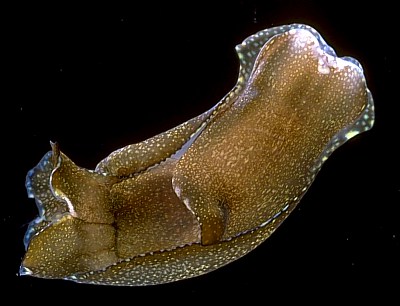
Philinopsis troubridgensis
(Verco, 1909)
Order: CEPHALASPIDEA
Superfamily: PHILINOIDEA
Family: Aglajidae
DISTRIBUTION
South Australia
PHOTO
Port Lincoln, Eyre Peninsula, South Australia, 5m. 26mm long alive. February 1985, AM C145120. Photo: Bill Rudman
A large species growing to more than 90mm in length. Has a brown reticulate pattern with some yellow and black speckling especially along the edge of the parapodia. Apparently a burrowing sublittoral species, Burn (1989) reports it feeding on a range of cephalaspidean bubble shells. There are few records of living animals, most being of animals washed up on beaches after storms.
Reference:
• Burn, R.F. (1989) Opisthobranchs (Subclass Opisthobranchia). [In] Marine Invertebrates of Southern Australia, Part 2. [Eds: Shepherd,S.A., Thomas, I.M.] Government Printer (South Australia), Adelaide, 725-788.
• Rudman, W.B. (1972) A comparative study of the genus Philinopsis Pease, 1860 (Aglajidae, Opisthobranchia). Pacific Science, 26(4): 381-399.
Rudman, W.B., 2001 (July 30) Philinopsis troubridgensis (Verco, 1909). [In] Sea Slug Forum. Australian Museum, Sydney. Available from http://www.seaslugforum.net/find/philtrou
Related messages
Philinopsis troubridgensis from South Australia (1)
May 16, 2003
From: Bill Rudman
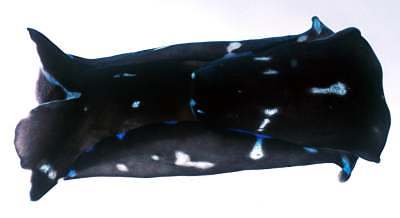

Here are some photos of some juveniles of Philinopsis troubridgensis. This is one of the largest species of the genus, growing to at least 90mm in length. These individuals ranged in size from 12-26mm long and ranged in colour from black with a few white and blue specks to animals with a brownish reticulate pattern. In all cases the dorsal crest at the back of the head shield is relatively large and held upright.
Kirton Point Wharf, Port Lincoln, Eyre Peninsula, South Australia, 5m, February 1985. Upper Photo: 18mm long alive; Lower Photo: 26mm. AM C145120. Photos: Bill Rudman.
If anyone has photos of larger specimens of this species they would be welcome.
Best wishes,
Bill Rudman
Philinopsis troubridgensis from South Australia (2)
May 16, 2003
From: Bill Rudman
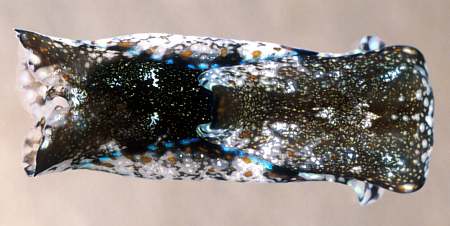
Here are some more photos of juvenile Philinopsis troubrigensis showing colour variation. It would seem that they start life a small black animals with white and blue spots and gradually develop the reticulate pattern found in adults.
Boston Bay, Nth of Port Lincoln, Eyre Peninsula, South Australia, 3m, amongst filamentous algae, February 1985. Upper Right: 20mm long. Lower photos: both 15mm long. AM C145116. Photos: Bill Rudman.
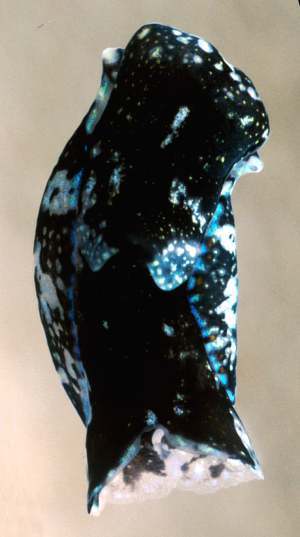
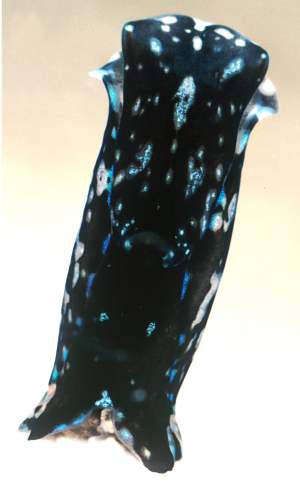
Philinopsis troubridgensis from South Australia
August 1, 2001
From: Nigel Holmes
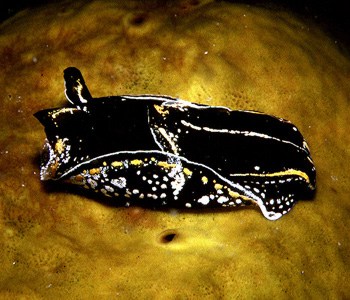
Dear Bill
Thanks for identifying the Phyllodesmium magnum
This aglajid is from South Australia, some years ago. Living in sand, 5m of water, sheltered coast near Edithburgh on Yorke Peninsula. South Australia.
Best regards
Nigel Holmes
Rockhampton, QLD.
holmesnjc@optusnet.com.au
Holmes, N., 2001 (Aug 1) Philinopsis troubridgensis from South Australia. [Message in] Sea Slug Forum. Australian Museum, Sydney. Available from http://www.seaslugforum.net/find/4898Thanks Nigel,
This is Philinopsis troubridgensis, one of the largest, if not the largest species in the genus growing to more than 70mm in length. If you have any idea of its size it woulfd be an interesting record as there are very few observations of living animals. As a sublittoral burrower in muddy sand it seems to have missed the attention of the intertidal colector and the scuba diver. Most records are either from dredged material or from moribund, dying animals washed up on the shore.
Best wishes,
Bill Rudman
